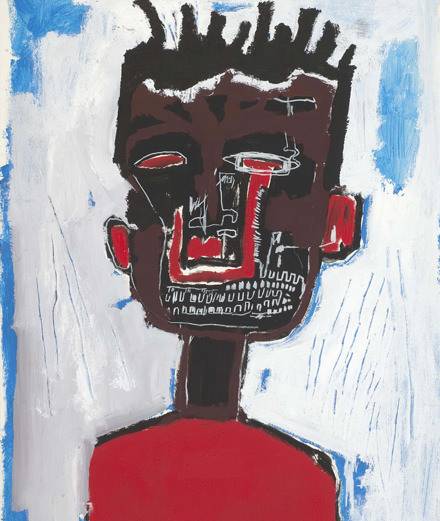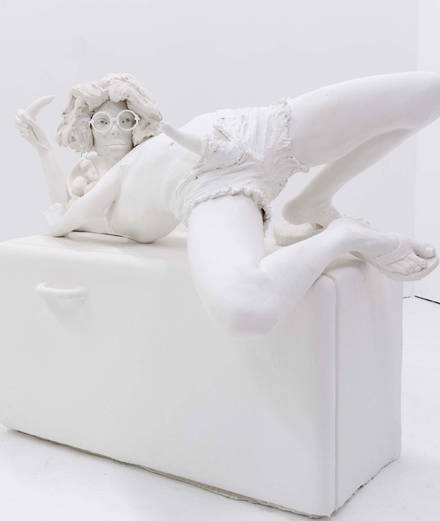

London’s Lisson Gallery sits off a shabby segment of the Edgware Road. Despite contemporary art’s supposed powers of gentrification, Bell Street has remained resolutely un-hip. Five decades after the gallery first opened, Lisson’s neighbours include a supplier of bulk nuts, a wireless repair shop and a funeral parlour. Yet every six weeks or so the pavement pulses with Comme des Garçons, red lipstick and white wine as new exhibitions are revealed in the gallery’s two buildings. Early in the morning, Nicholas Serota, the former Tate director, might be spotted, dashing along, overcoat flapping, as he heads to a private view. The fear of missing something wonderful brings them here, as it has since 1967 when hundreds queued to visit an exhibition of works by Yoko Ono.
Lisson’s director Nicholas Logsdail still lives “above the shop,” just as he did in the 1970s when Sol LeWitt or Dan Flavin would come and stay while they prepared work for a show. Back then, gallery owners were fellows in chalk-striped suits with spaces in Mayfair. Logsdail had encountered such dealers with his uncle, the author Roald Dahl, who he would accompany on gallery visits. Logsdail certainly didn’t think of himself in those terms when, at the age of 22, he opened a space to show work by his contemporaries at the Slade School of Art. “When you’re in your late teens, early 20s, you have an enormous capacity for curiosity, you want to know about how the world works,” he explains. “My generation knew nothing about marketing or anything like that.”
Money is clearly not an issue : Logsdail has stumped up six-figure sums for certain projects, among them Ai Weiwei's exhibition Disposition, shown alongside the 2013 Venice Biennale, and Anish Kapoor's Leviathan (2011) at the Grand Palais.
It was through his Uncle Roald, too, that Logsdail encountered the artist Matthew Smith, and decided already as quite a small child that art was the life for him. Smith would apparently invite the wide-eyed, eight-yearold Logsdail to come into his studio and draw. “He was incredibly accommodating to me. I was so interested in what he was doing. That smell of oil paint and turpentine – I’ll never forget it,” says Logsdail, who still has a fine landscape painting by Smith hanging in his private office. As an artist himself, Logsdail was apparently not without merit: a student work of his was selected for the 1966 New Contemporaries show at the Tate gallery. “If I wanted to be a little bit facetious, I’d say, ‘Well, having shown at the Tate before I was 21, I mean, why carry on?’” he jokes.


From his first encounters with an art world teetering on the brink of transformation, Logsdail took his Lisson Gallery as a passport to explore and engage with all that this marvellous new universe had to offer as a facilitator rather than practitioner of art. “It was clear to me within two or three months that the world I had been in was the world of students, and want-to-be young artists, most of whom would drop out in the first year,” he recalls. The year after the gallery opened, he travelled to Germany and New York, testing the waters, visiting shows, meeting artists. He was convinced that something momentous was afoot: the stirrings of conceptual art. “I was incredibly fortunate to be part of a truly historic moment. That, to me, was clear. I very much doubt it was clear to more than a very few people in London the late 60s – maybe one or two curators at the Tate. I saw how this whole new art world was creating a new, international network. The posh ‘Gentleman Jim’ art dealers on Cork Street had no idea this was happening at all.”
Emboldened by early successes, Logsdail wrote letters of introduction to New York artists whose work excited him. “In 1970, the first sign of a new and a much more international consciousness kicked in with Donald Judd and Sol LeWitt’s first show,” he recalls. The shows started a domino effect that saw Lisson work with the leading artists of the era: “Judd and Flavin knew each other, Flavin knew Dan Graham, Graham knew Carl Andre, Andre knew LeWitt, Robert Ryman knew LeWitt…” As well as showing their work, Logsdail “plugged them in to the British art world,” introducing them to London artists and helping them find teaching positions.
Today, the wooing of an artist in another territory would entail a complex courtship, including negotiations with galleries on their home turf and the commitment to costly shipping of works by expert art handlers. Things were simpler in the 1970s. “Actually, all you needed to do was establish a relationship with them, send them a plane ticket and look after them,” recalls Logsdail “You’d ship the artist not the work.” Sometimes accommodating them in his flat above the gallery, he discovered that “looking after” the artists could always throw out surprises.
A more recent newcomer is Marina Abramovic, who, despite her fame, long struggled to monetize her performance works.
During one visit, Logsdail took Flavin on a week-long trip around the British countryside in his new Citroën DS. They visited Stonehenge, but what really exited Flavin was haute cuisine, an expensive taste that the young gallerist realized he was going to have to cover. Flavin found a restaurant with a renowned wine cellar and excellent kitchen listed in the Michelin Guide. “By about 2.30 he’d drunk his way through a bottle of Château Lafite, had had this delicious lunch – all the courses – and was very happy. He said, ‘You know, this is the most wonderful experience of my life, gastronomically speaking,’” recalls Logsdail, who suggested that they both retire for a nap. “He said, ‘No, no, I don’t want to sleep. I want to do it again!’ I said, ‘What, you mean tomorrow?’ He said, ‘No, now!’” To the restaurant’s bemusement, Logsdail arranged for Flavin to eat the whole meal over again, start to finish.
In the late 1970s, the gallery became home to a new generation of British sculptors, artists of Logsdail’s own age: Tony Cragg, Richard Deacon and Richard Long. They were followed, in the early 1980s, by Anish Kapoor, one of only two artists, Logsdail says, that he’s signed straight out of art school. “The work was so singular,” he recalls, though he dismisses the idea of “discovering” artists: “The process is to look for artists who’ve already started to define their language in a convincing way that actually communicates with you. That’s what your radar picks up.”


While money is clearly not an issue – Lisson has stumped up six-figure sums for certain projects, among them Ai Weiwei’s exhibition Disposition, shown alongside the 2013 Venice Biennale, and Anish Kapoor’s Leviathan (2011) at the Grand Palais – Logsdail is supportive of artists whose practice is less evidently commercial. When we met, an entire gallery was filled by a site-specific three-dimensional grid in razor wire by Santiago Sierra. “That just might be a major iconic work that’ll symbolize this particular era in our unfortunate history,” muses Logsdail. Advisers to some of the wealthiest collectors have told him they require art that’s not just important but also beautiful; so why show a Sierra piece that is hostile and alienating? “Because he’s a great artist and it’s a great work.”
Since 1970, Lisson has represented John Latham, who infamously lost his St. Martins College teaching post in 1966 when he chewed up a library copy of Clement Greenberg’s Art and Culture and returned the book’s “essence” as a phial of fermented spit. This year Latham has been honoured with a solo show at the Serpentine and an extensive display at the Venice Biennale: Logsdail clearly banked well in playing the (very) long game. A more recent newcomer is Marina Abramovic, who, despite her fame, long struggled to monetize her performance works. Logsdail has hosted Abramovic at his house on Lamu, an island off the coast of Kenya that has been the site of a number of informal artist residencies. While there, she confessed all the mistakes in her life to a donkey that she stationed in Logsdail’s backyard. The donkey walked off after an hour, and Abramovic felt “a little better.” (Writing about her time in London in the early 70s, Abramovic said Lisson was her “favourite” gallery, but confessed she was too shy to speak to the young man at the front desk – Logsdail – who would become her gallerist 40 years later.)
Lisson’s 50th birthday will be celebrated by an Irma Boom-designed book and an ambitious off-site exhibition, Everything at Once, showing greatest hits, recent works and new commissions. Today Lisson has two new spaces in New York, run by Logsdail’s son Alex. But papa isn’t going to step aside just yet. Looking back over Lisson’s five decades “has woken me up in a way,” he says. “I feel very energized to get back into the curiosity department!”
Everything at Once, until december 10th, Store Studios, 180 The Strand, London.









